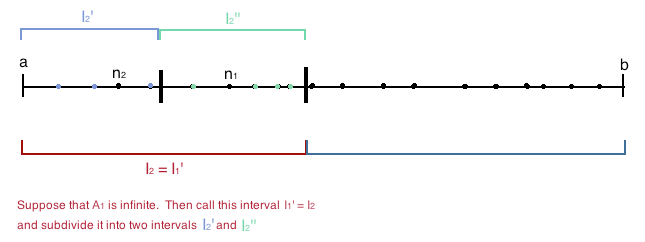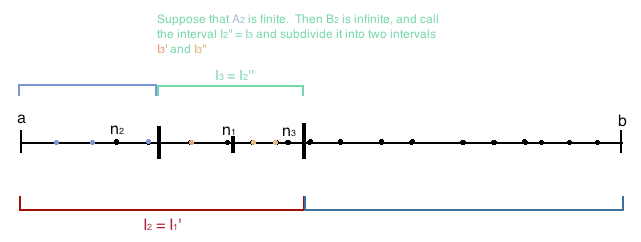Theorem:Bolzano-Weierstrass
Jump to navigation
Jump to search
Theorem 1 (Bolzano-Weierstrass): Let be a bounded sequence. Then there exists a subsequence of , call it that is convergent.
- Proof 1: Let be a bounded sequence, that is the set is bounded. Suppose that is a lower bound for this set, and is an upper bound for this set, and so for all . Therefore the set is contained in the interval .
- Let's take , i.e., let the first term of the subsequence be equal to the first term of the parent sequence .
- We will now take the interval and divide into two subintervals of equal length. We will call these intervals and . We will also divide the set of indices into two sets. Let and let . We note that is the set of indices greater than the first index in our subsequence, , such that is in the interval . Similarly, is the set of indices greater than the first index in our subsequence, such that is in the interval .
- We note that both of the sets and cannot be finite since and contain all of the indices of the sequence which has infinitely many indices since it is an infinite sequence. If is infinite, then we let , and we will let be the smallest natural number index in the set , which we are ensured to have by the Well Ordering Principle. If is finite, then is infinite and we let and we let be the smallest natural number index in the set , which once again, we are ensured to have by the Well Ordering Principle.
- We will now take the interval and subdivide it into two subintervals of equal length, call them and . Once again, we will subdivide the set of indices into two sets. Let and let .
- Once again, if is infinite, then we will let , and let be the smallest natural number index of . If is finite, then is infinite and let be the smallest natural number index of .
- We will then take the interval and subdivide it into two subintervals of equal length, call them and . We will also subdivide the set of indices into two sets. and
- We will continue this pattern to obtain a sequence of nested intervals . Furthermore, we will also have a subsequence of where for every .
- We also note that the length of any interval is precisely equal to . By the nested intervals theorem there exists a common point for all , and so we have that:
- Therefore the subsequence converges to .
- Proof 2: Let be a bounded sequence. By the <a href="/the-monotone-subsequence-theorem">The Monotone Subsequence Theorem</a>, every sequence of real numbers has a monotonic subsequence. Let be this monotonic subsequence. Since is bounded, it follows that is also bounded since the values are contained in the sequence . Since is both bounded and monotonic, then by <a href="/the-monotone-convergence-theorem">The Monotone Convergence Theorem</a>, is a convergent subsequence.
Theorem 2: If is a bounded sequence such that every convergent subsequence of converges to then converges to .
- Proof: Suppose that does not converge to . Then there exists a subsequence and an such that for all .
- Since is bounded, any subsequence of is also bounded, and so the subsequence is bounded. Since is bounded, then by the Bolzano-Weierstrass theorem there exists a convergent subsequence of . Since is a convergent subsequence of , then it is also a convergent sequence of by transitivity, and by the hypothesis, converges to .
- But then convergence of to contradicts the assumption that , and so the assumption that did not converge to was false. Therefore converges to .
Licensing
Content obtained and/or adapted from:
- The Bolzano-Weierstrass Theorem under a CC BY-SA license







![{\displaystyle I_{1}=[a,b]}](https://wikimedia.org/api/rest_v1/media/math/render/svg/fff23ca0f8aad5e4d787b2d1c52baa6b5c7c427f)



















































